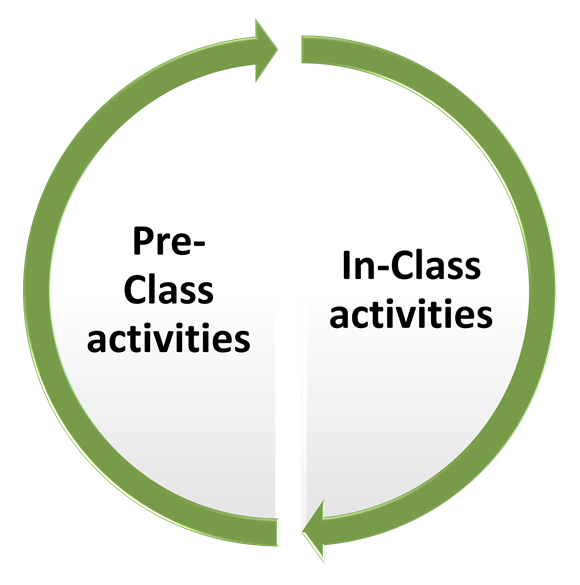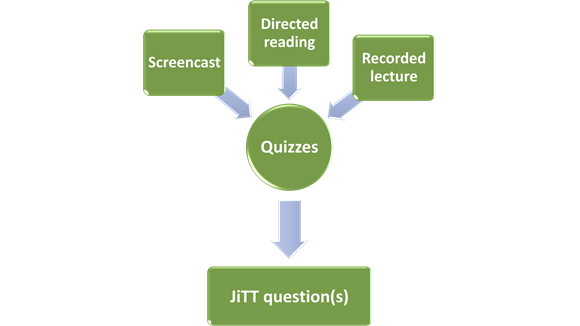
THEME: Just-in-Time Teaching - theoretical background and in practice
By using the Just-in-Time Teaching (JiTT) approach you encourage your students to active participation in the teaching sessions, to reflect, to acknowledge the perspectives of other students, to actively employ the matter learnt, relate it to other aspects of the subject and to be better prepared. JiTT increases your possibilities to better exploit your teaching time with your students, and to create an inspiring environment for teaching and learning.
The JiTT approach, developed by Gregor Novak, is an approach to optimize synchronous teaching, be it face-to-face or online. Focus is on the simultaneous presence by using asynchronous online preparatory activities, in order to create a feedback loop: between preparatory and synchronous learning activities, and between students and teachers.
The main concept of the JiTT approach is that before a teaching session, the students carry out one or more online activities as part their preparation. For the students this should result in a better use of the material studied, increased curiosity and interest, and increased student learning. The teachers should have better opportunities of preparing his/her teaching activities, based on student interaction and possible student responses, in the form of clarifying questions and/or comments to the material studied. This is defined as JiTT feedback loop between teaching, learning and activities, in and outside the class – see figure 1.
 Figure 1 – The JiTT feedback loop (adapted from Novak & Patterson, 2010)
Figure 1 – The JiTT feedback loop (adapted from Novak & Patterson, 2010)
Over the years, many types of learning activities have been developed starting from the same learning theories. These activities have of course been linked to the technological development of e-learning tools, but basically, the activities can be organized in 2 groups with matching criteria for successful completion (Novak, 2011):
- Activities, prepared by the teacher. These activities must be of high quality, that is, thoroughly prepared and founded on learning theories.
- The students’ responses must be integrated in the teaching activities, not just as a separate supplement.
Starting from these criteria, and not least the main concept of feedback loops between teaching and learning and pre- and in-class activities, it is also worth noticing that the pre-class exercises should be linked to the in-class teaching with and activating and exploring perspective, thereby forming the basis for a creative and improvisational learning space, based on a teacher-student team.
Implementation of JiTT
To obtain the best effect of the JiTT question it can be necessary to introduce not only the exercise itself, but also the material related to the exercise. Depending on the context and not least the question itself, in can also be expedient to have introductory quizzes, possibly with automatic feedback, in order to clarify misunderstandings and unclear concepts. The below figure 2 outlines the 3 phases.
 Figure 2 - Pre-class JiTT (adapted from Rowley & Green, 2015)
Figure 2 - Pre-class JiTT (adapted from Rowley & Green, 2015)
In case the questions introduce new material or new concepts, or if the questions are of a complexity that requires a detailed knowledge of literature or other prerequisites, it is important that the questions include definitions, explanations and possibly examples. That is, elements that you would normally introduce in class, and which will make it possible for the students to answer. Remember that in this case time is not a decisive factor – there is time for reflection.
You may for example present to the students an introductory video or a podcast, parts of recorded lectures etc. Be aware not to have too much text – this will soon remove the interactive element from the session.
It is recommended to make a quiz with questions for clarification of misunderstandings, for your own and for the students’ sake – use for instance a quiz with rapid feedback. It is also recommended to have a concluding question that offers the students the possibility of asking open clarifying questions.
Design of JiTT questions demands a little reflection and not least adaption to subject, lessons and class, but basically a series of JiTT questions should have the following characteristics. They should:
- Be of a certain difficulty – it should not be possible to answer the questions simply through references or search engines.
- Be sufficiently broad to give the students the possibility to formulate individual answers, preferably based on own experiences and prior knowledge.
- Be sufficiently open so that the students can formulate answers in their own wording, based on underlying concepts and supplementary information.
- Not be of such an extent that they would be too time-consuming, for the students and for yourself.
It is a good idea to think of JiTT questions as questions that you would usually ask during class. Remember, that it would be desirable if the questions can form the basis for professional discussions and /or abstractions on a higher level.
Timing of questions
The closer to the class session the questions are published, the better. This will help all parties involved have both questions and answers fresh in their memory, thereby increasing the intensity in the teaching. Still, the deadline must allow the students to answer the questions and you to check the answers. We usually recommend posting the questions the night before, but the optimum deadline would be a few hours before the teaching session starts.
JiTT and Peer instruction
If you already use JiTT in your teaching, or if you use Peer Instruction, we clearly recommend you to consider combing JiTT and Peer Instruction, possibly even in a Flipped Learning course.
Feel free to contact us for further information.
References
Physics Courses. American Journal of Physics, 66(1), pp64–74
Novak, G. M. (2011). Just-in-time teaching. New Directions for Teaching and Learning, 2011(128), 63-73. https://doi.org/10.1002/tl.469
Simkins, S.P. & Maier, M.H. (Eds.) (2010). Just-in-Time Teaching: Across the Disciplines, Across the Academy. Virginia, USA: Stylus Publishing, LLC